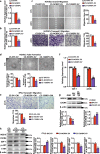Extracellular vesicles engineering by silicates-activated endothelial progenitor cells for myocardial infarction treatment in male mice
- PMID: 37055411
- PMCID: PMC10102163
- DOI: 10.1038/s41467-023-37832-y
Extracellular vesicles engineering by silicates-activated endothelial progenitor cells for myocardial infarction treatment in male mice
Abstract
Extracellular vesicles have shown good potential in disease treatments including ischemic injury such as myocardial infarction. However, the efficient production of highly active extracellular vesicles is one of the critical limitations for their clinical applications. Here, we demonstrate a biomaterial-based approach to prepare high amounts of extracellular vesicles with high bioactivity from endothelial progenitor cells (EPCs) by stimulation with silicate ions derived from bioactive silicate ceramics. We further show that hydrogel microspheres containing engineered extracellular vesicles are highly effective in the treatment of myocardial infarction in male mice by significantly enhancing angiogenesis. This therapeutic effect is attributed to significantly enhanced revascularization by the high content of miR-126a-3p and angiogenic factors such as VEGF and SDF-1, CXCR4 and eNOS in engineered extracellular vesicles, which not only activate endothelial cells but also recruit EPCs from the circulatory system.
© 2023. The Author(s).
Conflict of interest statement
The Shanghai Institute of Ceramics Chinese Academy of Sciences has applied for two patents related to silicate bioceramic ion solutions for the treatment of myocardial infarction, in which one has been granted and another is pending. J.C. and C.O. are the inventors of these two patents. The remaining authors declare no other competing interests.
Figures










Similar articles
-
Hydroxysafflor yellow A promotes neovascularization and cardiac function recovery through HO-1/VEGF-A/SDF-1α cascade.Biomed Pharmacother. 2017 Apr;88:409-420. doi: 10.1016/j.biopha.2017.01.074. Epub 2017 Jan 22. Biomed Pharmacother. 2017. PMID: 28122306
-
Sustained release of endothelial progenitor cell-derived extracellular vesicles from shear-thinning hydrogels improves angiogenesis and promotes function after myocardial infarction.Cardiovasc Res. 2018 Jun 1;114(7):1029-1040. doi: 10.1093/cvr/cvy067. Cardiovasc Res. 2018. PMID: 29566124 Free PMC article.
-
17β-estradiol promotes recovery after myocardial infarction by enhancing homing and angiogenic capacity of bone marrow-derived endothelial progenitor cells through ERα-SDF-1/CXCR4 crosstalking.Acta Biochim Biophys Sin (Shanghai). 2018 Dec 1;50(12):1247-1256. doi: 10.1093/abbs/gmy127. Acta Biochim Biophys Sin (Shanghai). 2018. PMID: 30371725
-
Endothelial Progenitor Cell-Derived Extracellular Vesicles: A Novel Candidate for Regenerative Medicine and Disease Treatment.Adv Healthc Mater. 2020 Jun;9(12):e2000255. doi: 10.1002/adhm.202000255. Epub 2020 May 6. Adv Healthc Mater. 2020. PMID: 32378361 Review.
-
Endothelial Progenitor Cell-Derived Extracellular Vesicles: Potential Therapeutic Application in Tissue Repair and Regeneration.Int J Mol Sci. 2021 Jun 15;22(12):6375. doi: 10.3390/ijms22126375. Int J Mol Sci. 2021. PMID: 34203627 Free PMC article. Review.
Cited by
-
Treatment of Denervated Muscle Atrophy by Injectable Dual-Responsive Hydrogels Loaded with Extracellular Vesicles.Adv Sci (Weinh). 2025 Mar;12(10):e2412248. doi: 10.1002/advs.202412248. Epub 2025 Jan 21. Adv Sci (Weinh). 2025. PMID: 39836492 Free PMC article.
-
Platelet membrane decorated exosomes enhance targeting efficacy and therapeutic index to alleviate arterial restenosis.Theranostics. 2025 Jan 1;15(2):408-427. doi: 10.7150/thno.103747. eCollection 2025. Theranostics. 2025. PMID: 39744678 Free PMC article.
-
Trimethylamine-N-Oxide Impedes Late Endothelial Progenitor Cell-Mediated Revascularization by Triggering Mitochondrial Apoptosis via Suppression of MnSOD.Cardiovasc Ther. 2025 Jun 18;2025:9910333. doi: 10.1155/cdr/9910333. eCollection 2025. Cardiovasc Ther. 2025. PMID: 40568449 Free PMC article.
-
Optimizing Cell Therapy by Sorting Cells with High Extracellular Vesicle Secretion.bioRxiv [Preprint]. 2023 May 30:2023.05.29.542772. doi: 10.1101/2023.05.29.542772. bioRxiv. 2023. Update in: Nat Commun. 2024 Jun 7;15(1):4870. doi: 10.1038/s41467-024-49123-1. PMID: 37398351 Free PMC article. Updated. Preprint.
-
New approach of modern pharmacology: from gasotransmitters to traditional mineral drugs.Med Gas Res. 2025 Mar 1;15(1):139-141. doi: 10.4103/mgr.MEDGASRES-D-24-00022. Epub 2024 Jun 26. Med Gas Res. 2025. PMID: 39436186 Free PMC article. No abstract available.
References
Publication types
MeSH terms
LinkOut - more resources
Full Text Sources
Other Literature Sources
Medical

